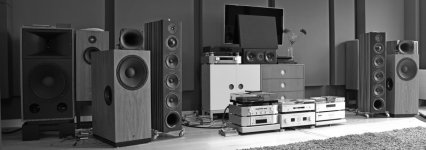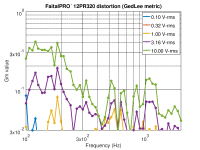If there was any truth to low Qms being something bad, the Dynaudio line of legendary tweeters (Esotar, Esotec, D28/2 etc...) would never have sounded as great as they did, and still do! Their speciality has always been in revealing the finest details in a recording.
There's no denying the quality of Dynaudio drivers (the crossovers are another story).
However, after owing several pairs, mainly from the older Contour line, and having experience with many of their top of the line loudspeakers (Crafft, Evidence etc.), I discovered the importance - not to say: the magic of η₀ (efficiency).
Dynaudio drivers, specifically the woofers, like most contemporary high-end hifi drivers, are designed to provide the most linear, well-behaved response possible. This objective implies several trade-offs that ultimately results in inefficient drivers.
There's an old interview with Joachim Gerhard in which he also touches on Qms and Qes.
The last paragraph on the first page is particularly interesting, although he cites energy loss while he means lower efficiency (as a result of electrical and mechanical losses).
Efficiency alone is not the ultimate goal, but in my view it is indeed very important.
Here's another telling quote from the old Lambda Labs website:
"You cannot look at Bl without also including the resistance or Re of the speaker at the same time. They are directly related to each other in a speaker, one does not do anything on its own. Bl means nothing without Re, this is a very important point to understand with relation to driver parameters.
Now let us look at a speaker motor playing a wide bandwidth of frequencies. First we have to assume that if the voice coil is in the gap, both the B and the l of Bl do not change. However, to get the same amount of force ( B * l * i ) across the entire frequency bandwidth, you need to keep the same amount of current at all frequencies. To do this you need to keep the same impedance at all frequencies to keep the same current. The main limiting factor preventing the voice coil from having a flat impedance above the resonance peak and doing this is its self inductance. This is the real determinate of driver "speed"!
This self inductance increases the impedance of the voice coil the higher in frequency it goes. The current goes down, and hence the Force has to go down as the current goes down. Eventually you will come to a frequency that no current can flow in the driver! Now since lower frequency drivers need more voice coil wire to get more xmax, they also create more self inductance as a byproduct. Thus when you hear someone talk about "slow" drivers, what they really are describing are drivers that are bandwidth limited.
Now there are other issues to the bandwidth, it is not just the self inductance. There are issues with the diameter of the diaphragm, the shape and depth of the diaphragm, the diameter of the voice coil, etc. However the self inductance is the majority contributor for 99% of loudspeakers."
Modern drivers are highly bandwidth limited, which is why most hifi manufacturers focus on multi-way loudspeaker systems that sound similar.
This is partly due to the hi-fi press, with Stereophile at the forefront, who from the 1970s onwards introduced measurement methods with associated benchmark ratings, whereby low-efficiency, linear loudspeaker systems achieved higher scores.
ATC, Dynaudio and Genelec are found in many studios across the globe, as they are ideal tools for mixing and mastering.
Another important factor that has also played a dominant role in the development of both hi-fi and professional drivers since the 1970s is "size".
Since we're all familiar with Hofmann's Iron law, we know how size relates to efficiency.
Whenever I visit my best buddy I can still enjoy his 85dB Dynaudio column speakers with ESOTAR T330D tweeters, but I definitely wouldn't trade my 100dB system for those.
Last edited:
Apparently, I have an ally in ScottG.
In brackets the values of my most efficient drivers (15").
Caveat:
ALL-ELSE-EQUAL
1st:
"efficiency" (Sensitivity): The higher the better. (6.06%)
2nd:
Qe: The lower the better. (0.34)
3rd:
Mms: The lower the better. (52.321 g)
4th:
-"generically" Rms: the lower the better. (..I say "generically" because often at the smallest excursion it isn't the spider but rather the surround that dominates, and Rms is mostly about the spider.) (1.644 Kg/s)
...of course there is a deep relationship between 1, 2, & 3.
In brackets the values of my most efficient drivers (15").
Caveat:
ALL-ELSE-EQUAL
1st:
"efficiency" (Sensitivity): The higher the better. (6.06%)
2nd:
Qe: The lower the better. (0.34)
3rd:
Mms: The lower the better. (52.321 g)
4th:
-"generically" Rms: the lower the better. (..I say "generically" because often at the smallest excursion it isn't the spider but rather the surround that dominates, and Rms is mostly about the spider.) (1.644 Kg/s)
...of course there is a deep relationship between 1, 2, & 3.
Just kidding.There's an old interview with Joachim Gerhard in which he also touches on Qms and Qes.
The last paragraph on the -f-i-r-s-t- second page is particularly interesting,
Interesting arguments. A couple of moths ago I listened to some Dynaudios at a local Hifi-store and I was shocked to hear how dump and dull they sounded. Dead and lifeless to my ear, but every sound was coated in a tangible surface finish which probably is what gets them sold. The shop owner was very proud to present SACD of piano concert with some panning SFX added in mastering to me. It was obviously true that I could almost point at the source, which to me it seems was not only the effect of a tall, slim floorstander that injects a lot of room acoustics into the mix, but was highly dependent on the very silky sound which kind of laid back, but also not moving me. Compared to this, I have been working on my 2-way with compression driver and a Faital 12 Inch woofer with "high" QMS (7.8) and I have to admit this pornographic detail is not there. Could be that it is just the opposite function, reduction of resonance/higher damping, that makes this possible.
Also I can agree to what Rob quoted from Scott, that the properties of high efficiency speakers make for good low level listening qualities. I was very surprised, but this sort of speaker sound very good turned down.
... Lambda Labs...
Nick McKinney knew his stuff.
Most good drivers today have pole pieces treated to dramatically reduce HF inductance.
A tidbit in his bit you quoted was the impedance and the current. These are key as we start to discuss current amplifiers and high Rout voltage amplifiers.
Beyond the driver inducrtance one can strt thinking about how XOs screw with impedance.
Nick’s legacy lives on in JOHn’s Audio Elegance drivers. The Apollo upgrade is the bit that flattens the impedance and extends the HF.
dave
Also I can agree to what Rob quoted from Scott, that the properties of high efficiency speakers make for good low level listening qualities. I was very surprised, but this sort of speaker sound very good turned down.
Assigning tose qualities to high efficiency speakers is misplaced. There are lower effiecency drivers that are outstanding in this respect.
A loudspeaker driver has a huge number of compromises in it, and given that it is combitorial the breadth of design options is huge. Trying to pigeon hole a driver based on a few numbers collaped from multi-dimensional curves is very faught with room for broad over generalizations.
All the compromises going into a driver design form a gestalt, and considering less tan a handful to characterize a driver is a big mistake when one really have to juggle hundreds of details.
In the end it is “what does it sound like?”
Some of the very best speaker swe have built in terms of low level satisfaction. It likely has a lot more to do with DDR than effieceny.
dave
Hi dave,
I did not mean to say this is the only property that allows ist. The remark was rather a shared experience. And I agree, this is just as subjective as your résumé:
I did not mean to say this is the only property that allows ist. The remark was rather a shared experience. And I agree, this is just as subjective as your résumé:
I agree there is many factors, but I find this perspective particularly dissatisfying. There has to be a the possibility to group and categories the most relevant properties of a speaker in this regard, at least the components have been build on the basis of concepts too, not singular experience. Based on singular experience, I can say that when I was searching for the woofer that I use at the moment, I was informed by the conception that low Mms enables better mid range capabilites in a 12 Inch woofer, quite desireable in a (huge) 2-way system, high Qms would help with dynamics and BL do the rest. And until now, again, only based on the little share that my subjective experience can uncover from Ἀλήθεια, and maybe compared to some heavy drivers like the Dynaudio, it seems to have played out nicely. If we want to introduce more complexity into the whole consideration of high Qms, I'd prefer to do it only to the ends of reaching a more thorough conception of what it can do for a speaker.In the end it is “what does it sound like?”
As this thread is about the significance of Qms, that of the 15" in post #62 is 10.
Here's another interesting notion about woofers and Xmax.
@sheeple, the woofer is the FaitalPRO 12PR320?
This woofer qualifies as a wide-band driver and combines exceptional mid range performance with ample low frequency extension.
An example of a prototype 2-way with that driver is shown in the foreground:
Here's another interesting notion about woofers and Xmax.
@sheeple, the woofer is the FaitalPRO 12PR320?
This woofer qualifies as a wide-band driver and combines exceptional mid range performance with ample low frequency extension.
An example of a prototype 2-way with that driver is shown in the foreground:
Attachments
Last edited:
I agree there is many factors, but I find this perspective particularly dissatisfying.
You are trying to simplify something complex so you can get your head around it.
There are no right answers. There are some bad ones thou.
dave
I don't think I have been simplifying, please re-read. Accounting for complexity is one thing, another is giving up on pattern recognition, making hypotheses and creating theorems in order to simplify the vast excess of experience and data that is too complex to work with. It is necessary to isolate core conceptions which in turn can then be applied to complex matters to see if they will iluminate complexity. Maybe this is the same what you mean with no right answers, you got to say something, even if it's wrong for now.You are trying to simplify something complex so you can get your head around it.
I took note of this thread while ago but only yesterday I reread and realized that the woofer I use (yes Rob, 12PR320) has a sort of uneven mid range response in the micro-level. Unsmoothed between 200 to 1000 Hz there is quite some jumpyness to observe. I tended to see the cause only in my bold port implementation (resonance), but found that this might also be because of high Mms. I found this interesting, what it means for sonic rendition, this "mobility".
Last edited:
There has also been some discussion in a speaker review in another forum (JBL 4349, got quite some problems), what makes it sound spectacular despite the issues. And also separates it from a very good speaker with ceramic woofers (?, think so, anyway heavy stuff), but very different sound. People talked about compression and distortion a lot a lot, but the woofer Jbl 1200fe-8 (might be further modified for this application, but should be close) has Qms of 15! Came to my mind. I am happy if there is more than this to the sound, could be an important element though.
addition:
addition:
Always loved the look of these speakers. Rob, please can you give me some idea what you base the classification "exceptional mid range performance" on, appart from listening experience? I tried to tackle this deliberately before I bought the drivers, can they do it?, but could not get aswers what makes the mid range of a 12 Inch good. Some said take this driver, some proposed another, but little criteria was presented. So I focused on Mms, Qms and BL with fs another concern because it's role in a 2-way.@sheeple, the woofer is the FaitalPRO 12PR320?
This woofer qualifies as a wide-band driver and combines exceptional mid range performance with ample low frequency extension.
Last edited:
There are no right answers. There are some bad ones thou.
dave
True and driver design is a balancing act > you can't have it all.
Dynaudio, Scanspeak, SB-Acoustics drivers are linear (inefficient) within narrow bands.
Imo the most important distortion component is IMD, which is inherently bandwidth-related.
You either optimize for minimizing IMD in the low frequency-band (up to about 300-400Hz) which requires Xmax, motor force and adequate compliance > lossy suspension > low efficiency, or you focus on the mid range, which requires other design trade-offs inherent to the physics involved (shorter wavelengths).
An example of a typical low frequency woofer is the B&C 15TBX100 that was used by Vance Dickason for his big 2 way studio monitor.
On a French forum the B&C was compared to the Beyma 15WR400, a midwoofer.
Unfortunately the plots are lost, but here are some findings:
"The 15tbx100 is a recent techno monster with double spider, supporting 1000w aes with its heavily ventilated 4 inch coil.
The 15wr400 is a relatively light woofer of simple but quality construction with an expo profile diaphragm and simply 3 inch vented coil (400w aes).
Impedance in the open air measured with Limp in sine mode for more precision. fs of 33Hz for the B&C and 40Hz for the Beyma. Basically, it corresponds to the specs, the Beyma gives 4dB more which largely compensates for its "low" power for bass / low midrange use as long as you do not want to go down too much. The B&C will excel in serious low frequency use with very low distortion in this area and the extent of its response. On the other hand, the Beyma wins in terms of distortion over the entire midrange and seems much clearer when listening."
Furthermore, 2 classic Beyma 15" woofers were compared, the SM115K (low. freq. woofer) and SM115N (mid woofer):
"I do not see why they could not go up properly to 600hz, the SM115K does it very well.
If you compare it with the sm115n, it is coherent.
One can be used up to 1kHz and higher, the other to 600Hz or even slightly higher. But there will still be trade-offs, even cutting at 500Hz / 600Hz.
We will either compromise on the bass (sm115n) or the midrange (sm115k).
Ditto, we take almost 10dB more distortion in the midrange or the bass depending on the high pass used, it isn't negligible."
Attachments
-
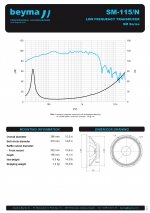 beyma-speakers-data-sheet-low-mid-frequency-SM115N_Pagina_2.jpg364 KB · Views: 161
beyma-speakers-data-sheet-low-mid-frequency-SM115N_Pagina_2.jpg364 KB · Views: 161 -
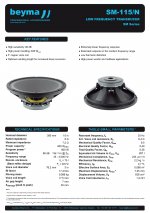 beyma-speakers-data-sheet-low-mid-frequency-SM115N_Pagina_1.jpg438.5 KB · Views: 169
beyma-speakers-data-sheet-low-mid-frequency-SM115N_Pagina_1.jpg438.5 KB · Views: 169 -
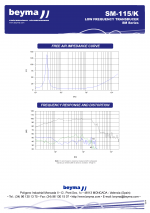 SM115K_Pagina_2.png57.9 KB · Views: 395
SM115K_Pagina_2.png57.9 KB · Views: 395 -
 SM115K_Pagina_1.jpg565 KB · Views: 436
SM115K_Pagina_1.jpg565 KB · Views: 436 -
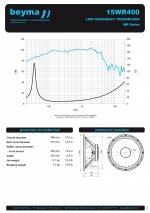 beyma-speakers-data-sheet-low-mid-frequency-15WR400_Pagina_2.jpg387.2 KB · Views: 433
beyma-speakers-data-sheet-low-mid-frequency-15WR400_Pagina_2.jpg387.2 KB · Views: 433 -
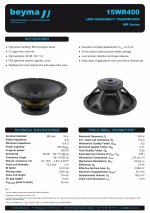 beyma-speakers-data-sheet-low-mid-frequency-15WR400_Pagina_1.jpg448 KB · Views: 442
beyma-speakers-data-sheet-low-mid-frequency-15WR400_Pagina_1.jpg448 KB · Views: 442 -
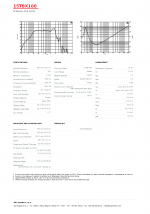 BC_15TBX100_8Ω_Pagina_2.png193.3 KB · Views: 458
BC_15TBX100_8Ω_Pagina_2.png193.3 KB · Views: 458
Last edited:
Can you give me some idea what you base the classification "exceptional mid range performance" on, apart from listening experience? I tried to tackle this deliberately before I bought the drivers, can they do it?, but could not get aswers what makes the mid range of a 12 Inch good. Some said take this driver, some proposed another, but little criteria was presented. So I focused on Mms, Qms and BL with fs another concern because it's role in a 2-way.
It's hard to tell exactly without knowing the technical details of the driver's construction, but we can guess.
1. It's a 12" with a fairly light cone > lower tendency to flex and higher break-up freq. compared to 15" woofers.
2. The magnet structure and the chassis is more advanced than that of the older 15PR400, despite the traditional looks.
3. The spider looks like a recent Dr. Kurt Muller product.
4. Idem for the cone + surround.
I see you also participate in the Monkey Coffin thread, in which the 12PR320 was selected as the most suitable driver.
Nbrennwa measured the parameters.
Mean values:
fs = 43.1 (datasheet: 7.2)
Qes = 0.44 (datasheet: 0.39)
Qms = 8.2 (datasheet: 7.8)
Qts = 0.42
It's probably not a coincidence that the parameters related to Qe and Qm are tending towards the values of my 15" (Mms is nearly identical). However, Fs of the latter is higher and Qts lower, which suggests lower losses and therefore a focus on midrange reproduction, rather than bass.
All in all, the 12PR320 seems to strike a nice balance between low end and midrange performance.
Distortion measurements of the 12PR320:
Attachments
Last edited:
Obviously, the 12PR320 is not designed for extremely high SPLs, which is illustrated by the AES rating. It should still be loud enough for use in smaller clubs, without premature failure due to mechanical / thermal overload.
Personally, I do not understand the choice of such a woofer in a loudspeaker system which sensitivity is far below that of the woofer.
Throttling efficiency doesn't make sense.
Personally, I do not understand the choice of such a woofer in a loudspeaker system which sensitivity is far below that of the woofer.
Throttling efficiency doesn't make sense.
Last edited:
I do not understand the choice of such a woofer in a loudspeaker system which sensitivity is far below that of the woofer.
Throttling efficiency doesn't make sense.
I am confused about this statement. Would you care to explain?
The sensitivity of the 12PR320 is 97 dB-SPL/2.83Vrms/1m into 2pi. That's 91 dB-SPL/2.83Vrms/1m into 4pi. Allow some minor losses in the xover and box damping, and you're at 90 dB-SPL/2.83Vrms/1m into 4pi, which is what we get for the Monkey Coffin.
That said, I feel this thread has lost its focus.
it is quite difficult to consider Qms independent of the other parameters, don't you think?
Perhaps I should have omitted that last comment, since the sensitivity of the 12PR320 is a bit lower than I had in mind.
I'm not a fan of attenuating woofers and prefer to tune the sensitivity / efficiency / output of the system to the lowest frequencies rather than the other way around.
The latter is apparently not the case with the Monkey Coffins and to be honest while glancing over your thread, I was reminded of Troels, who claims a system sensitivity of 95/96 dB for his Faital 3WC-15, which is miraculous since the specified sensitivity of the dome tweeter is 93.5 dB.
Perhaps I should have omitted that last comment, since the sensitivity of the 12PR320 is a bit lower than I had in mind.
I'm not a fan of attenuating woofers and prefer to tune the sensitivity / efficiency / output of the system to the lowest frequencies rather than the other way around.
The latter is apparently not the case with the Monkey Coffins and to be honest while glancing over your thread, I was reminded of Troels, who claims a system sensitivity of 95/96 dB for his Faital 3WC-15, which is miraculous since the specified sensitivity of the dome tweeter is 93.5 dB.
it is quite difficult to consider Qms independent of the other parameters, don't you think?
That really depends on the context. If you are designing a box for a woofer, you'll have to consider more than just one parameter. However, the subject of the thread is (or was 9 years ago) what significance of high Qms is. This is basically a question of what physical properties are covered in the Qms parameter, and if/how these properties may be important.
Qms is a derivative of a few mechanical properties and only is of any interest in the resonant working area of the driver. It would be more useful to consider the mechanical impedance across the working frequency area. I think some here would be surprised that the acoustic impedance plays quite a role too. I truly don't understand people who claim a high Qms would be beneficial for midrange frequency reproduction. Get your physics right, I'd say.
Perhaps I should have omitted that last comment, since the sensitivity of the 12PR320 is a bit lower than I had in mind.
I'm not a fan of attenuating woofers and prefer to tune the sensitivity / efficiency / output of the system to the lowest frequencies rather than the other way around.
The latter is apparently not the case with the Monkey Coffins and to be honest while glancing over your thread, I was reminded of Troels, who claims a system sensitivity of 95/96 dB for his Faital 3WC-15, which is miraculous since the specified sensitivity of the dome tweeter is 93.5 dB.
Hi Ro808,
My take is any 12" used as a woofer (without a subwoofer), is about 90dB efficient at best, when asked to go low.
All the published sensitivity specs for 12" drivers are for mid-bass use only, imo.
The variability and pure judgement call in manufacturers' sensitivity specs is one of my pet peeves. But that said, most do provide response curves, so it's our own fault i guess, if we place too much credence in the single number spec.
Personally, i look at the curve and gauge sensitivity to be close to the lowest level of output in the band of intended use. Much more real world ime.
Measurements of drivers using full-band pink noise with xovers and response leveling EQs in place, have confirmed that 'real world sensitivity' to me many times.
(I measure an averaged SPL (LEQz) vs an average rms voltage, over the same time interval. A real and simple spec imho))
What's always interesting after measuring each drivers' individual sensitivity like that, is how their noncoherent pink noise outputs sum for a higher overall speaker sensitivity in terms of an SPL meter reading....something not shown with sine sweeps.
Hope this wasn't too OT...
Of course I agree with your arguments, Mark.
For the same reason 8-9 out of 10 professional mid woofers of the same size exhibit a comparable low freq. response when mounted in similar cabs.
Anechoic / 4Pi is the most accurate measurement method, which was established long ago by Floyd Toole, Dave Smith and others.
Therefore I do not dispute bennwa's arguments, because he considers the matter from a developer's perspective.
However, in an average living room, depending on placement (and preferences), reproduction of low frequencies becomes a completely different story. Personally, I adhere to the adage "less is (often) better", in terms of extension. Besides, -3dB between 50-60Hz with 5 watts is enough to get neighbors to call the police.
"Sensitivity" is misleading when considering individual drivers. η₀ is more informative because it's the ratio of the energy dispersed from the cone in all directions to the power applied to the woofer.
Regarding 12-21" woofers, I consider η₀<2% to be low efficient.
From this point of view, the 12PR320 matches the Volt VM752 pretty well, because the efficiency is only 0.5% apart, in favor of the Faital, which is obviously beneficial.
Although my focus is primarily on compression drivers and pro woofers, I can certainly appreciate a large dome mid.
For the same reason 8-9 out of 10 professional mid woofers of the same size exhibit a comparable low freq. response when mounted in similar cabs.
Anechoic / 4Pi is the most accurate measurement method, which was established long ago by Floyd Toole, Dave Smith and others.
Therefore I do not dispute bennwa's arguments, because he considers the matter from a developer's perspective.
However, in an average living room, depending on placement (and preferences), reproduction of low frequencies becomes a completely different story. Personally, I adhere to the adage "less is (often) better", in terms of extension. Besides, -3dB between 50-60Hz with 5 watts is enough to get neighbors to call the police.
"Sensitivity" is misleading when considering individual drivers. η₀ is more informative because it's the ratio of the energy dispersed from the cone in all directions to the power applied to the woofer.
Regarding 12-21" woofers, I consider η₀<2% to be low efficient.
From this point of view, the 12PR320 matches the Volt VM752 pretty well, because the efficiency is only 0.5% apart, in favor of the Faital, which is obviously beneficial.
Although my focus is primarily on compression drivers and pro woofers, I can certainly appreciate a large dome mid.
Qms is a derivative of a few mechanical properties and only is of any interest in the resonant working area of the driver. It would be more useful to consider the mechanical impedance across the working frequency area. I think some here would be surprised that the acoustic impedance plays quite a role too. I truly don't understand people who claim a high Qms would be beneficial for midrange frequency reproduction. Get your physics right, I'd say.
I suppose you're referring to Zm(ω) = F(ω)/V(ω)?
If so, then you obviously know that at low frequencies a woofer ideally behaves like a damped mass-spring system with a specific resonance frequency, and towards the midrange we are increasingly dealing with modal behavior / break-up.
In an earlier post I cited some examples of woofers that are optimized for either bass or midrange. It's balancing act if you want to cover both with 1 woofer.
A matter of pick your poison.
Why do you think many highly rated classic woofers from Altec, JBL, TAD etc. usually have a Qms ≥ 5?
Dr. Peter Strassacker, Loudspeaker designer since 1977:
"Qms is a measurement for the mechanical Q factor of a driver. It's dependent on the loss of the mechanical suspension (diaphragm surround and spider).
This value should be as high as possible."
Last edited:
- Home
- Loudspeakers
- Multi-Way
- The significance of high Qms..?
